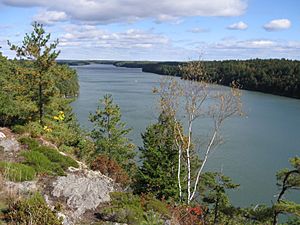Francis Small facts for kids
Francis Small (born 1625 – died around 1714) was a British-born person who became a trader and a huge landowner in America. He lived mostly in Kittery, Maine. He is famous for making the very first recorded land purchase in what we now call the state of Maine. Back then, this area was part of the Massachusetts Bay Colony. Francis Small bought so much land that people called him "the great landholder." He owned more land than anyone else who ever lived in Maine!
Contents
Francis Small's Life and Business
Francis Small was born in 1625 in England. He came to New England with his father around 1632. He was the only one of his brothers and sisters to come to America.
In 1648, he lived in Dover, New Hampshire. Around 1650, he married Elizabeth Leighton. In 1657, while living in Casco (now Portland, Maine), he bought about 200 acres of land. He bought it from Scitterygusset, a local Native American leader called a sagamore.
In 1659, Francis Small set up a trading camp on Sebascodegan Island. This island is now part of Harpswell, Maine. By 1668, he lived in Kittery. But he also ran a trading post near where the Ossipee River and Saco River meet. This spot is now Cornish, Maine.
This location was perfect for trading furs with Native Americans. Many important Native American trails met there. These included the Sokokis Trail, the Ossipee Trail, and the Pequawket Trail. But living so far out in the wilderness also had its dangers.
A Dangerous Warning
One day, Chief Wesumbe, a leader of the Abenaki tribe, warned Francis Small. He told Small that some angry tribesmen were planning to kill him. These men owed Small money for goods they bought on credit. They were supposed to pay him back with furs in the fall. Instead, they decided to kill him to avoid paying their debt.
Their plan was to set his house on fire at dawn. When Small ran out, they would shoot him. At first, Small thought the warning was a trick. He thought they just wanted to scare him away so they wouldn't have to pay.
But to be safe, he hid on a nearby hill. From there, he could watch his trading post through the trees. Just as Chief Wesumbe had warned, his trading post went up in flames at first light. Small ran away and did not stop until he reached Kittery.
How He Got So Much Land
To make up for his losses, Chief Wesumbe sold Francis Small a huge amount of land. On November 28, 1668, he sold him 20 square miles of land. This was about 256,000 acres! The land was between the Ossipee River, Little Ossipee River, and Newichewannock River.
The price for this huge area was:
- Two large Native American blankets
- Two gallons of rum
- Two pounds of gunpowder
- Four pounds of musket balls
- Twenty strings of Indian beads
This large purchase became known as the Ossipee Tract. It included what are now the towns of Limington, Limerick, Cornish, Newfield, Parsonsfield, and Shapleigh. Part of Shapleigh later became Acton. All these towns are in Maine today.
Francis Small then sold half of this land to Major Nicholas Shapleigh. Major Shapleigh lived in what is now Eliot, Maine. He was the richest man in the Piscataqua River area at that time.
Later Years and Land Claims
Around 1684, Small ran another trading post at Cape Small. This cape is named after him and is now in Phippsburg.
However, there were many conflicts with Native American tribes during this time. During King William's War, Native American warriors allied with French forces attacked and destroyed English settlements. The area became deserted.
Around 1700, Francis Small moved from Kittery to Truro, Massachusetts. He went to live with his son, Daniel. Francis Small died about 32 years after Major Nicholas Shapleigh, who passed away in 1682.
Many years later, in 1770, the original document for the land sale from Chief Wesumbe to Francis Small was found. This was found by Small's family members. In 1772, Small's family and Shapleigh's family worked together to get back the land. They appointed a group to mark the towns' boundaries.
Francis Small's family took control of Cornish, Limington, Newfield, and half of Limerick. Shapleigh's family took Parsonsfield, Shapleigh, and the rest of Limerick. They gave the town of Limerick to their lawyer, James Sullivan, as payment for his help.


